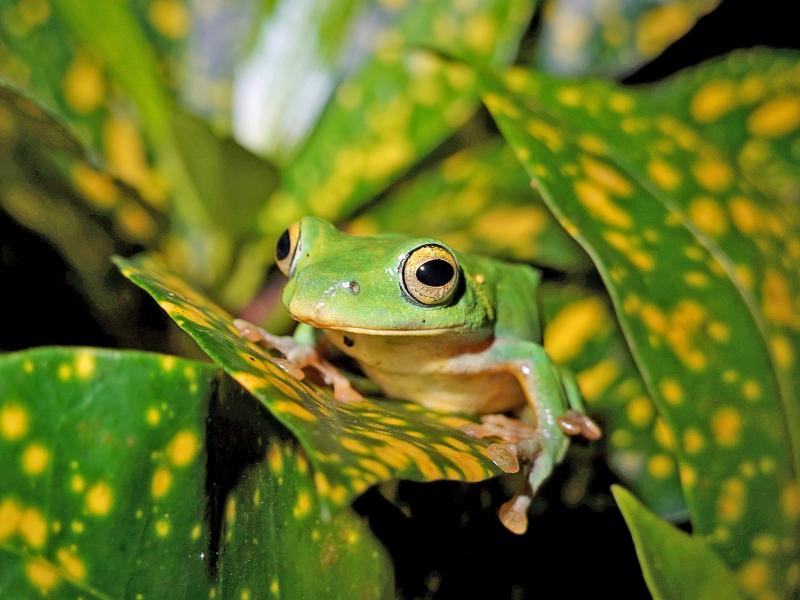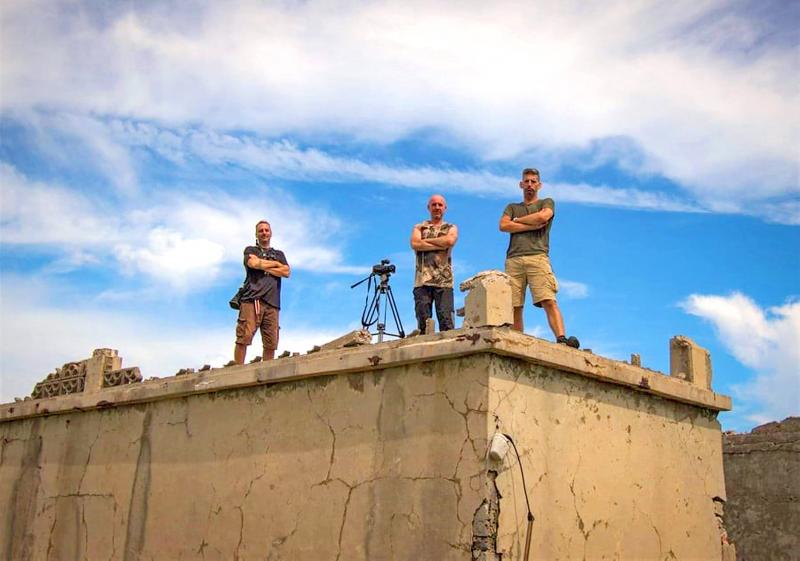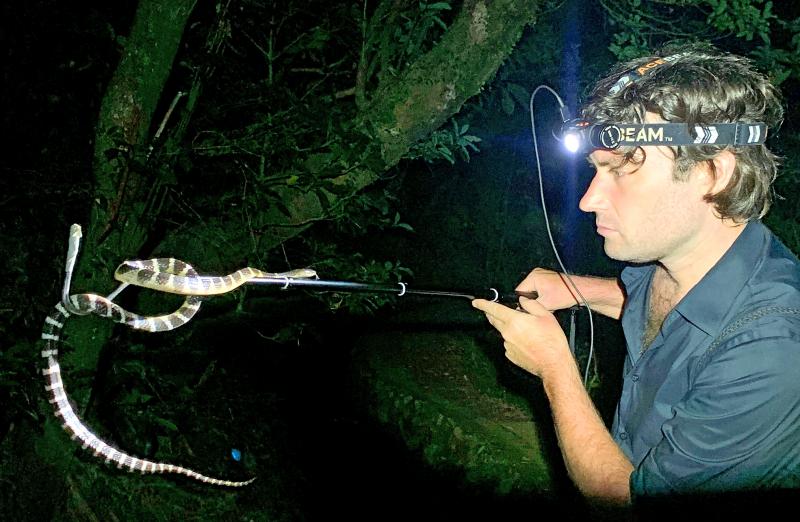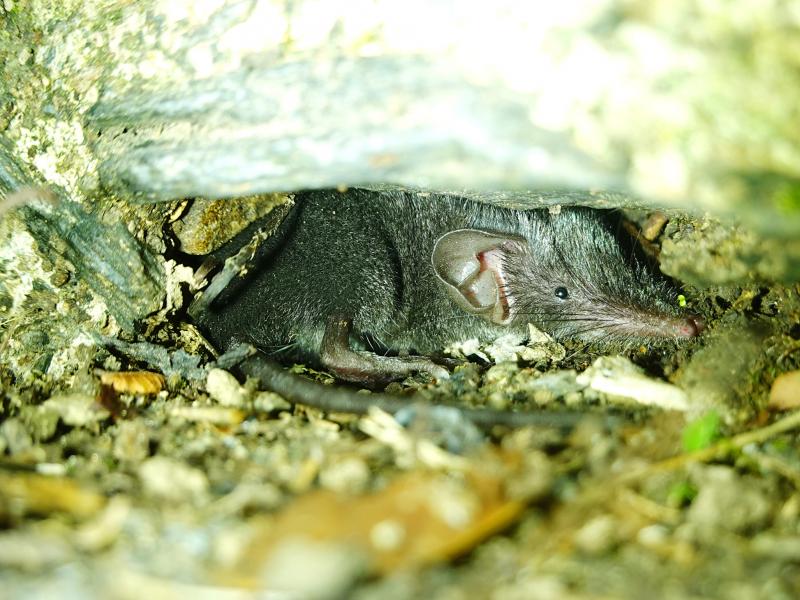TRAX
The team behind TraX is motivated by what host Dave Johnson sees as a lack of English-language documentaries that cover “contemporary history, nature, or the more quirky things about Taiwan ... also, what is available isn’t particularly impressive in visual terms.”
Shot and edited by Colin Phoenix, TraX is produced under the banner of Guan Xi Media, a Taichung-based platform for artists of all kinds.

Photo courtesy of James Osborne
Guan Xi Media is led by Michael Schram, a Canadian resident of Taichung. “Michael occasionally accompanies us when we shoot a video, but the most important thing is that Guan Xi Media is a registered media company. That carries a bit of weight and opens doors. Through it, we’re now members of Association of Taiwan Journalists (台灣新聞記者協會),” Johnson says.
The company’s senior translator and coordinator Kelly Zheng (鄭安閑) also significantly contributes to the production process, Johnson says.
“Guan Xi Media was looking to start a video series, and they found me through the stories and photography I’d put online. I went for a meeting to see if our interests matched, and they did,” Johnson recalls.

Photo courtesy of TraX
The series was named TraX to incorporate the X of Guan Xi and also to allude to “making tracks,” Johnson says. Guan Xi’s YouTube channel includes Urb-X, a series of urban exploration videos also made by Phoenix.
Before TraX got up and running, Phoenix had professional video and editing experience, “whereas I had absolutely no experience in front of the camera. I’m not a natural and I have to fight really hard to pull it off,” Johnson says.
“We felt that many of the videos showcasing Taiwan are vlogs, and they concentrate on things like food and night markets. We want to make mini-documentaries that will still be watchable and relevant 10 years from now,” says Johnson, an Englishman who’s lived in Taiwan for 12 out of the past 16 years.

Photo courtesy of James Osborne
“We have a real love of nature, the outdoors, history, and being out there on the ground” he says.
Of the 10 videos TraX has so far put out, Johnson is most proud of “Taiwan’s Ghost Island” (about a now-uninhabited island in Penghu County) and “Chasing the Sugar Train” (featuring the last functioning section of Taiwan Sugar Corp railroad): “They’re the most visually impressive. But I’m proud of all of them, despite fairly low viewing figures. We have an impeccable like/dislike ratio, and an exceptional ‘like’ engagement of about 10 percent.”
“Taiwan’s Ghost Island” has been nominated for a prize in the Formosa Festival of International Filmmaker Awards’ best focumentary short film category.

Photo courtesy of TraX
Unlike TraX’s other videos, which are based on research Johnson has done during the several years he’s been exploring the country, “Taiwan’s Ghost Island” benefited from input from local researchers.
The most difficult aspect of making videos, Johnson says, is dealing with weather and light issues.
“We’ve done two videos on railways, and we had to fit ourselves around their schedules to get the footage we need. If conditions aren’t ideal, we try our best to work around it,” he says.

Photo courtesy of James Osborne
The TraX team has encountered a few legal issues. After releasing a video featuring a tunnel they’d explored, they were contacted by the Forestry Bureau.
“Before we filmed, we weren’t able to find out who owned the tunnel. The Forestry Bureau then told us it fell under their jurisdiction, and they asked for the video to be taken down. We argued that the video was of educational importance and in the public interest, and they’d not made a serious attempt to seal up the tunnel,” Johnson says. In the end, the video was allowed to stay online because the bureau dropped their complaint.
JAMES OSBORNE
“From before I can remember, I was always poking around ponds and looking under logs and rocks for frogs, lizards, and bugs,” says James Osborne, who uploads videos of after-dark wildlife to YouTube under his own name.
Now living in Taipei, where he teaches English, the New Zealander has been building up his knowledge of ecology and geography, and researching local reptiles, amphibians, and mammals.
“If you follow my channel, you may notice I’m more and more informed about species as time goes by,” he says.
For practical reasons, he’s not invested as much time in studying birdlife or insects: “Birds are too hard to shoot with my setup. The bugs here can be otherworldly, but it’s hard to find much information and the diversity is too vast.”
“When you go out to look for wildlife, you never know what you might encounter, so you can’t prepare much for a shoot,” he adds.
Osborne says that once he’s finished shooting, he needs between 10 and 30 hours to edit the footage and add English and Chinese subtitles.
“I’m a one-man operation, but I have friends who proofread and correct my subtitles. I enjoy the whole process and everything I learn along the way,” he says.
If he ever monetizes his channel, he adds, any income will first go to paying someone to do the subtitles.
Shooting wildlife is hardly easy, Osborne explains: “Animals are just doing their thing and seldom cooperate with the shoot. Sometimes I’m hanging off a tree with a camera in one hand and a light in the other. Other times the subject is too fast, too far away, or just won’t face the way you want it to. You go into nature, and you get what nature gives you.”
Inevitably, he has come across wonderful sights but hadn’t been able to get his camera out in time. He describes such experiences as “exciting but a bit gutting.”
Osborne has noticed that how he feels about a finished video is no guide to how many views it’ll get. He was quite satisfied with “Dung Beetle Rolling Poop” — but it failed to set the Internet alight. A couple of others which he threw together in a rush have done much better.
In terms of views, “Finding Glowing Scorpions with UV Light,” which he shot on Kaohsiung’s Cijin Island (旗津), is the most successful of the 31 videos he’s uploaded to YouTube, probably because it received some media attention.
Osborne accepts that his channel is unlikely to ever make much money. “But it’s opened some doors and allowed me to meet like-minded people,” he says. “I’ve been approached by a company to sell them footage for a film about Yangmingshan (陽明山). I’ve made friends and contacts with others in Taiwan who adore or research wildlife. That in itself is worth more than gold.”
Steven Crook has been writing about travel, culture and business in Taiwan since 1996. He is the author of Taiwan: The Bradt Travel Guide and co-author of A Culinary History of Taipei: Beyond Pork and Ponlai.

“Why does Taiwan identity decline?”a group of researchers lead by University of Nevada political scientist Austin Wang (王宏恩) asked in a recent paper. After all, it is not difficult to explain the rise in Taiwanese identity after the early 1990s. But no model predicted its decline during the 2016-2018 period, they say. After testing various alternative explanations, Wang et al argue that the fall-off in Taiwanese identity during that period is related to voter hedging based on the performance of the Democratic Progressive Party (DPP). Since the DPP is perceived as the guardian of Taiwan identity, when it performs well,

The Taiwan People’s Party (TPP) on May 18 held a rally in Taichung to mark the anniversary of President William Lai’s (賴清德) inauguration on May 20. The title of the rally could be loosely translated to “May 18 recall fraudulent goods” (518退貨ㄌㄨㄚˋ!). Unlike in English, where the terms are the same, “recall” (退貨) in this context refers to product recalls due to damaged, defective or fraudulent merchandise, not the political recalls (罷免) currently dominating the headlines. I attended the rally to determine if the impression was correct that the TPP under party Chairman Huang Kuo-Chang (黃國昌) had little of a

At Computex 2025, Nvidia CEO Jensen Huang (黃仁勳) urged the government to subsidize AI. “All schools in Taiwan must integrate AI into their curricula,” he declared. A few months earlier, he said, “If I were a student today, I’d immediately start using tools like ChatGPT, Gemini Pro and Grok to learn, write and accelerate my thinking.” Huang sees the AI-bullet train leaving the station. And as one of its drivers, he’s worried about youth not getting on board — bad for their careers, and bad for his workforce. As a semiconductor supply-chain powerhouse and AI hub wannabe, Taiwan is seeing

Jade Mountain (玉山) — Taiwan’s highest peak — is the ultimate goal for those attempting a through-hike of the Mountains to Sea National Greenway (山海圳國家綠道), and that’s precisely where we’re headed in this final installment of a quartet of articles covering the Greenway. Picking up the trail at the Tsou tribal villages of Dabang and Tefuye, it’s worth stocking up on provisions before setting off, since — aside from the scant offerings available on the mountain’s Dongpu Lodge (東埔山莊) and Paiyun Lodge’s (排雲山莊) meal service — there’s nowhere to get food from here on out. TEFUYE HISTORIC TRAIL The journey recommences with